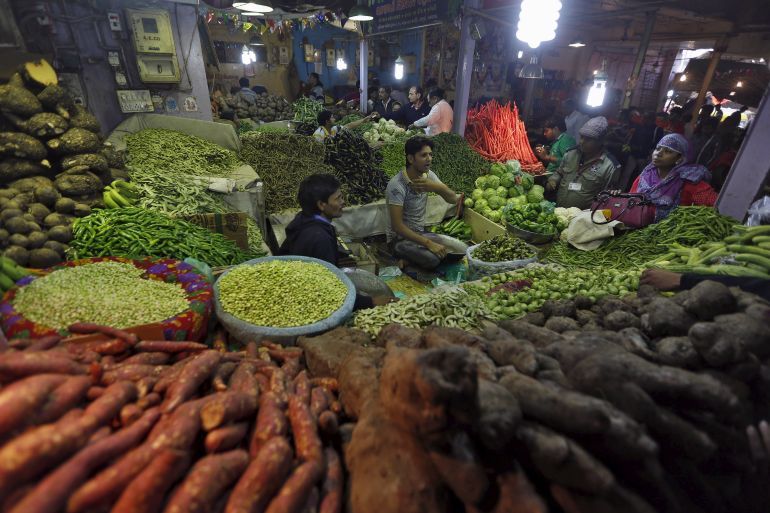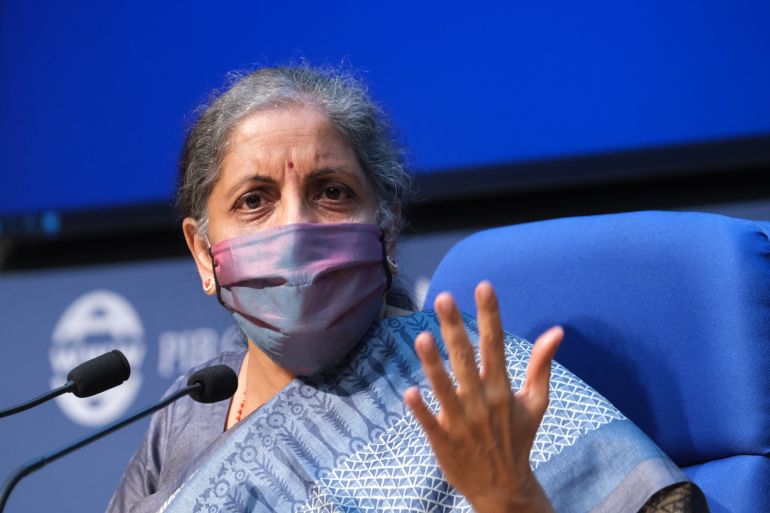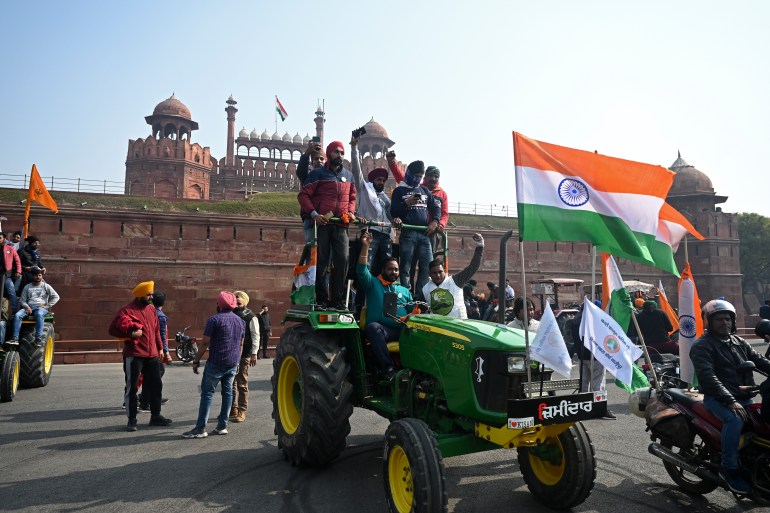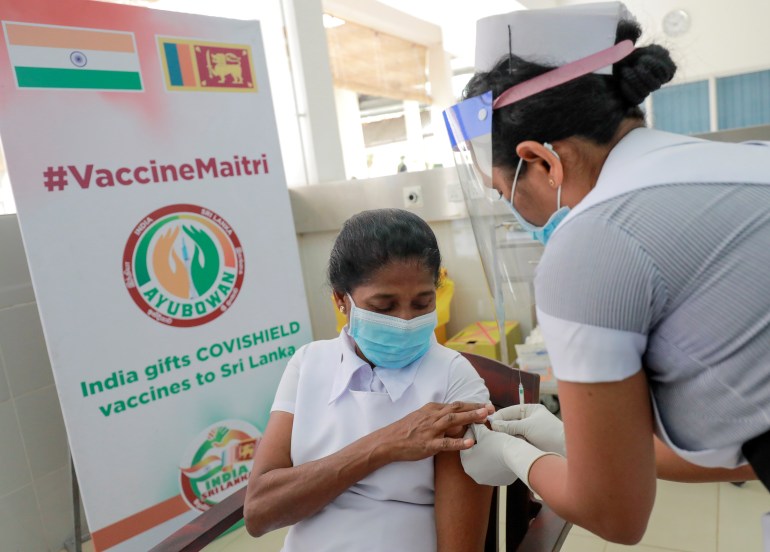India budget 2021: Can the government help consumers spend more?
India will have to spur consumer demand that was crushed by COVID, but the government has little fiscal space in which to manoeuvre.

Anurag Katriar used to run a chain of 25 restaurants across India before COVID-19 struck last year. By mid-March 2020, he was forced to close all of them as the country went into one of the world’s strictest lockdowns to control the spread of the virus.
Even after the lockdowns began to be eased in phases from June 8, Katriar decided to permanently shut down nine of his outlets. Another nine are due to reopen soon, but with a greatly reduced number of staff, and he says he has yet to decide what to do with the other seven.
Keep reading
list of 4 itemsIndian farmers reject government’s offer to suspend new laws
More Indian-made COVID vaccines will be released: Modi
Indian vaccine company warns of side effects days after approval
Katriar says he is hoping for what he describes as some “last-minute oxygen” for India’s food service industry in the government’s budget, which is due to be unveiled on Monday.
“The year gone by was like one bad dream and it created an existential crisis for all of us,” Katriar, CEO of deGustibus Hospitality and president of the National Restaurants Association of India, told Al Jazeera.
“It was not easy to stay shut for so many months and then start with so many restrictions,” he said referring to caps on the number of people who can be allowed in restaurants, shorter opening hours and an initial ban on selling alcohol.
But the restaurant industry is not the only sector that needs help. Finance Minister Nirmala Sitharaman is under pressure to spend heavily to create jobs and stimulate consumer demand, boost healthcare and education and improve the country’s creaking infrastructure ranging from its rail network to the energy sector.
But digging the country out of the hole it sank into following the coronavirus crisis is likely to be one of the toughest challenges facing any Indian government in modern times given the deep structural issues the country had even before the pandemic struck.
‘Bruised and battered’
Sunil Sinha, principal economist at India Ratings, a Fitch unit, says the pandemic has left companies and households “bruised and battered” and that it is “unlikely they’ll get back to their normal anytime soon”.

The job of restoring economic sentiment rests with the government and while it has been partly successful in augmenting supply chains and industrial production, he added, it has so far failed to kick-start demand which is ultimately what is needed to sustain industrial production. “That’s what has been missing. Unless the government does something significant on that account, the process of recovery will not accelerate,” he told Al Jazeera.
Part of the problem the government faces in rolling out big-spending initiatives is that the economy is expected to have shrunk by a huge 7.7 percent in its current fiscal year, which runs from April 1, 2020 to March 31, 2021, according to the government’s estimate.
In its economic report released on Friday, the government said it is expecting the economy to rebound by 11 percent in the coming fiscal year.
The 2020-21 slump takes into account a sharp economic bounce in the last two quarters as lockdowns eased. But a deeper look reveals the lopsided nature of the rebound.
Government spending, agriculture and electricity output are about the only parts of the economy that are likely to have registered positive growth over the fiscal year, the estimate shows. Everything else, including private consumption, long-term investment, trade, mining, manufacturing, construction and services are all still shrinking.
As a result of the shrinkage in the economy, the government is having to spend far more than it is receiving in taxes.
Sitharaman has since March announced four fiscal rescue packages. Altogether the government has spent 6 trillion rupees ($82bn) or close to 3 percent of India’s gross domestic product (GDP).
But that is below the average expenditure on COVID-19 relief measures of about 4 percent of GDP among emerging market and middle-income economies, according to the International Monetary Fund’s (IMF) Fiscal Monitor database of how governments are responding to the crisis. It is also lower than China’s response amounting to about 5 percent of GDP, and far below the roughly 10 percent average for advanced economies.

Even if Sitharaman wants to spend aggressively to repair the economy, several interlinked issues stand in her way.
Though unemployment has fallen sharply from a peak of 23.5 percent last April, it remains at 6.5 percent, and urban joblessness stands at 8 percent, according to a 30-day moving average estimate by the Centre for Monitoring Indian Economy.
High unemployment restricts the amount of tax revenue the government can collect. Even before the pandemic, only about 14.6 million people paid any income tax, according to the Income Tax Department. At just 2 percent of the population, India’s tax base is far smaller than the nearly 12 percent average for middle-income countries, as estimated by the World Bank.
Low tax revenues mean the government’s fiscal deficit – the shortfall in income compared with expenditure for a given period – is expected to balloon. A survey of economists by the Bloomberg news agency suggests the deficit for the year to end-March will be 7.25 percent of the size of the Indian economy, compared with the government’s plan of limiting it to 3.4 percent. Indian law stipulates that the deficit cannot rise above 3 percent of GDP.
As a result of the blowout in the deficit, some economists say the government needs to keep a lid on spending, even though millions of people are still suffering the effects of the pandemic.
‘Don’t expect anything’
“This budget needs to look at fiscal consolidation,” Madan Sabnavis, chief economist at CARE Ratings, told Al Jazeera. CARE expects the deficit to stand at about 8 percent of GDP this fiscal year.
The finance minister will need to lay out a “road map” of how it will more than halve the deficit within the next four years, Sabnavis said.
“It’s ok for all of us to expect the big things. Every sector wants something. But practically, don’t expect anything because all policies have been announced.”
![India fiscal deficit as percentage of GDP chart [Bloomberg]](/wp-content/uploads/2021/01/367621181-1.jpg?w=770&resize=770%2C500)
To cover its fiscal shortfall, the government needs to borrow money, mainly by issuing bonds. This adds to the national debt, creating yet more headwinds for the government.
“Record-high public debt levels limit the room for further fiscal support, particularly in countries where borrowing costs or access to financing impose constraints,” the IMF says in its latest edition of the monitor. “However, more needs to be done to prevent a large rise in poverty and income inequality, and promote a strong recovery amid heightened uncertainty. Fiscal policy will have to deliver more with less.”
India’s government debt certainly is high even among emerging economies, amounting to nearly 90 percent of GDP, according to IMF estimates for 2021. China’s is estimated at 66.5 percent.
But some economists disagree with the notion that the government should be reining in spending at such a critical point in India’s history.
India Ratings’ Sinha recommends the government be a “little less conservative on the fiscal side” and undertake a judicious combination of direct financial support to the poorest while also spending on infrastructure projects that have a quick turnaround period such as roads and houses in rural areas as well as low-cost housing in urban areas. Such projects will create jobs immediately, money earned from which could be spent on buying food, groceries and taking care of other necessities, in turn boosting the economy.
The final mile?
In addition to its COVID-induced balancing act, the government has other pressing issues to deal with. The most visible of these has been the thousands of farmers who have been protesting for weeks against the country’s new farm laws.

The government will likely include an aid package for the agriculture sector “given the immediacy of the protests”; and to get the private sector and households to consume more, Barclays India economist Rahul Bajoria told Al Jazeera.
Business owners and their employees working in industries such as hospitality, which have been among the worst hit due to restrictions on face-to-face interactions, are also desperate for more government help.
The Grand Hotel in the Indian capital, New Delhi, is just one of the many to have suffered. When the country went into lockdown, the travellers who were staying there were stuck. But other than them, the hotel had zero business for April, recalls general manager Vipul Kamboj.
Eventually, some revenue started trickling in when the government asked most hotels to make a few floors available for those who needed to quarantine. The hotel’s employees who chose to go home were allowed to keep their jobs but were considered to be on leave without pay and there were salary cuts across the board.
Today, some business travel has resumed and weddings are taking place again. But with a cap in New Delhi of 50 guests at any gathering, the hotel’s revenues are barely at 25 percent of 2019 levels, says Kamboj.
“We have good banquet halls, a large outdoor area which can accommodate 700 people but when only 50 guests are allowed, everybody feels lost in that,” he told Al Jazeera.
“The hotel sector may be a small income for the government but if you look at all the ancillaries [such as] guides, taxi drivers, roadside eating joints, the stores that sell curios, all of that depends on the leisure business and they’re all hit.”

Kamboj’s request to the government is to relax some rules for the sector including allowing hotels to serve alcohol outdoors and a relaxation in excise duties – a large expense – for a year or two.
But there is now some light at the end of what has been a long, dark tunnel.
With India now rolling out the world’s largest vaccination drive with plans to inoculate about 300 million people by August, most businesses are pinning their hopes on medical intervention to boost demand back to where it was before the pandemic hit.
In a note sent to Al Jazeera, Barclays’ Bajoria says that should the vaccination plan stay on track, as he expects it to, India will see “the final-mile unlocking of the economy” begin in the coming financial year and help drive recovery through the six months ending September.
He expects the economy to clock an 8.5 percent growth rate in the 2021-22 financial year, a more upbeat projection than his previous forecast of 7 percent, albeit from the battered base of this year.
“A manageable health crisis, along with the beginning of the vaccination drive should provide a major impetus to the economy over the next year,” the note said.